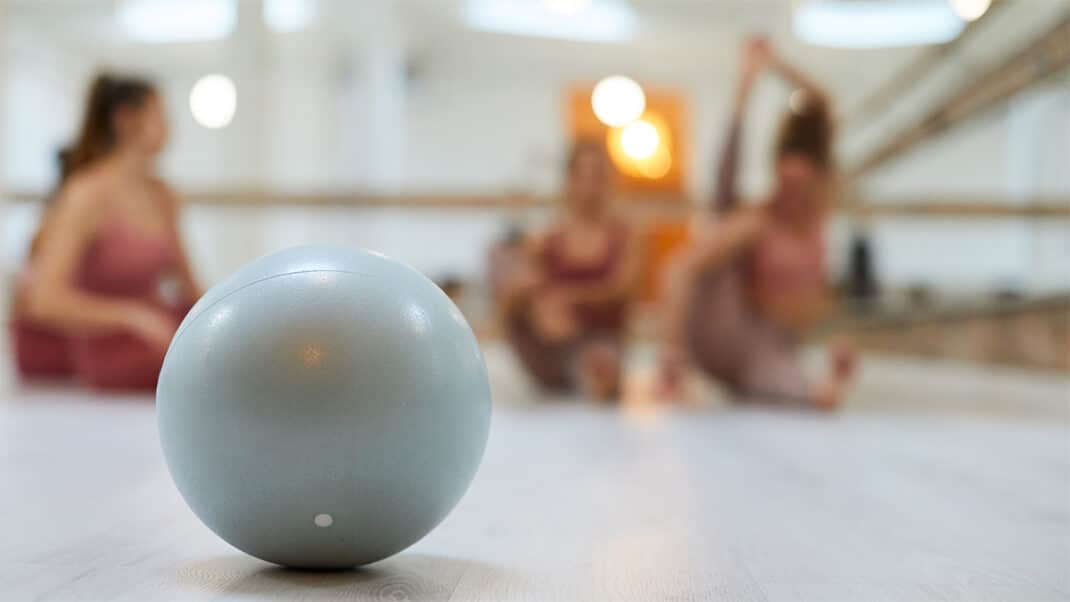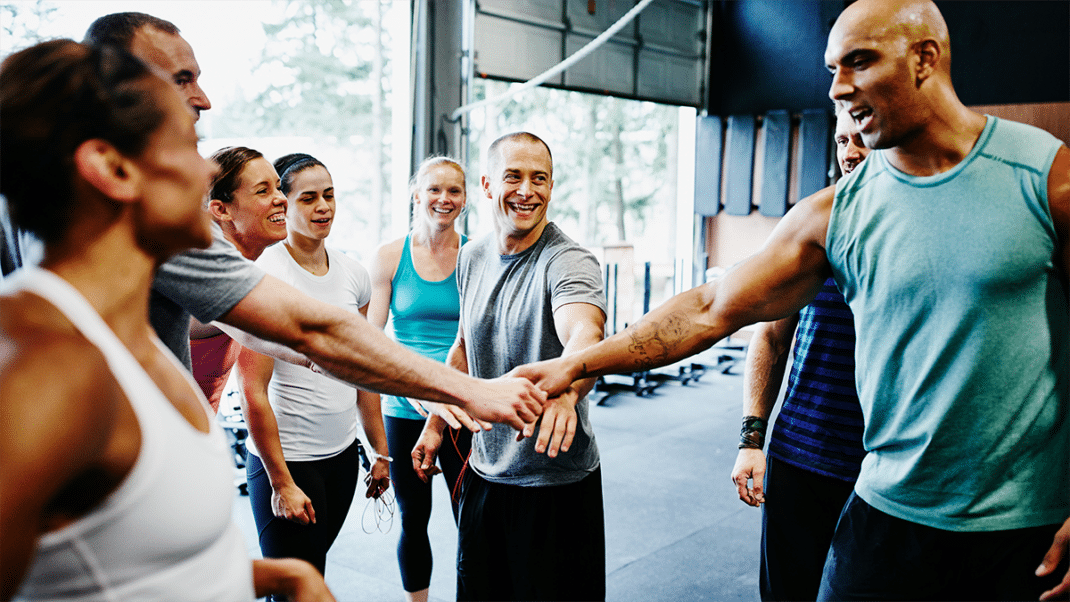Sample Class: Think With Your Heart
Get participants’ bodies and minds moving with a thoughtful class.

Cardiovascular exercise comes in two flavors: mindless and mindful. Why not layer cognitive tasks into your class design to train the brain as well as the body? Research shows that cardio exercise can help ward off cognitive impairments, develop the ability to coordinate multiple things, increase the ability to stay on task for extended periods and improve brain power (Lee & Jones 2008). Help participants meet the rigors of everyday life by adding mental challenges that also enhance balance, reaction time and agility.
Think With Your Heart Details
Total Time: 45 minutes
Format: low-impact cardio
Equipment Needed: none, except a positive attitude
Music: 115–135 beats per minute (depending on abilities)
Warm-Up (7–10 minutes)
Establish the movements. Keep things simple. Introduce four movements, one at a time. Perform 32 counts of an exercise before going on to the next one. Label each move with a number. For example:
- march in place: move #1
- step-touch: move #2
- knee lift: move #3
- hamstring curl: move #4
Embed the numbers. After establishing the movements, cue by number, not by name. When you say, “Number one,” for example, march in place for 16 counts. Next, call out, “Number two,” and then perform step-touch for 16 counts, and so on. Once everyone has learned the movements and their numbers, cue by number in random order for a few sets. Switching it up adds another layer, challenging participants to think about what they’re doing rather than just passively following your lead. Reduce the number of reps as participants demonstrate proficiency, working down to 8 counts of each move.
Introduce the walls. Assign a number to each wall. The front wall is #1, the right wall is #2, the back wall is #3, and the left wall is #4.
Cardio Training (20–30 minutes)
Layer the moves to the walls. When you call out, “Number one,” participants march in place (move #1) while facing the front wall (#1). When you cue, “Number two,” they turn to the right wall (#2) and perform step-touch (move #2). “Number three” means they face the back wall (#3) and change to the knee lift (move #3). And “Number four” cues them to turn to the last wall (#4) and perform the hamstring curl (move #4).
As you cue by numbers, not only do participants change movements but they change orientations to face the corresponding wall. You have to think about which way to face and which move to do. Use numerical reduction: 32, 16 and then 8 reps. After performing in numerical order, switch it up by calling numbers in random order. Are neurons getting exercised? Who needs complexity when the ability to make quick directional changes is more beneficial?
Add travel. Bring everyone back to “Number one,” marching in place, facing front. Add travel—walking forward and back, 4 counts each. Repeat several times. Instruct participants to march in place again.
Split the room. Divide class in half. Instruct the left (L) half to continue to march in place. Instruct the right (R) half to prepare to walk forward and back, 4 counts each direction. When ready, cue the R half to begin doing this. The R half continues walking forward and back as you prepare to direct the L half of the room.
Create a zigzag. As the R half walks backward, cue the L half to walk forward, creating a zigzag effect. The locomotor movement has not changed, but you’ve created a different dynamic by splitting the room and staggering the walks.
Add a push-pull. As the zigzag walk continues, change orientation by asking everyone to take smaller steps, covering less space, as they prepare to turn slowly and face the opposite group. Each group continues moving forward and backward until they have gradually turned 90 degrees toward the center of the room and are facing the other line. Once everyone catches on, you have a push-pull effect—one group walking forward toward the other group (which is backing up). Switch directions.
Introduce mirror-mirror drills. Cue both groups to stop walking forward and backward but continue to march in place while facing the opposite group. Call out for everyone to perform move #3 (knee lift) for 16 or 32 reps. Next, cue move #4 (hamstring curl) for 16 or 32 reps. Repeat as needed to recall these movements. Instruct the R half to continue performing move #4. Instruct the L half to prepare to change to move #3. At the appropriate time, give that cue. Half the class is now performing knee lifts, as the other half performs hamstring curls.
Explain that when you say, “Change,” everyone is to switch movements and perform what the other half is doing. Before you give the cue, they must look at the opposite group—not you—for visual guidance. Use numerical reduction: 32, 16 and then 8 counts. Plug in other simple locomotor movements, which may continue for 5–10 minutes. Next, bring everyone back to move #1. Divide the class into four groups. Each group moves to a different wall, faces the center of the room and marches in place.
Do traveling wall circuits. This drill moves one line at a time. Instruct people at walls #2, #3 and #4 to continue to march in place. Those at wall #1 walk to the opposite side. When they reach the opposite side, they do an about-face and walk back to their original wall. Once there, they march in place. Instruct those at walls #1, #2 and #4 to continue to march in place as you cue participants at wall #3 to walk to the opposite wall, turn around and walk back to their original wall. Continue this pattern with the remaining walls (#2 and #4). Repeat several times.
Do square-dance circuit. Participants continue doing move #1 (marching). Instruct those at walls #2 and #4 to stay in place. Those at walls #1 and #3 walk to the center of the room simultaneously. When they meet in the center, they turn around and walk back to their original wall. Repeat one more time. Next, those at the two remaining walls execute the same pattern twice while those at walls #1 and #3 march in place. By the end, everyone is back at their home wall, marching in place.
Let opposites attract. Participants do move #1 (marching). Instruct those at walls #2 and #4 to stay in place. Those at walls #1 and #3 switch places by walking to the opposite side of the room simultaneously. They must maneuver past each other as they switch sides. Repeat with those at walls #2 and #4. Do a few more rounds of this. Like walking in a crowded environment, this exercise involves observation, anticipation, directional change, reflexive action and balance.
No-Brainer Cool-Down (5–8 minutes)
Balance mindful cardio with a mindless cool-down. Cue participants to walk around the room at their own pace, socializing and relaxing their minds. Finish with static stretches for the ankle, knee and hip joints. Include upper-body stretches if time allows.
References
Ken Alan
Ken Alan is a lecturer in the department of kinesiology at California State University Fullerton and has served on certification committees for ACE, ACSM and AFAA. The author of four book chapters, he is on the editorial review board for the Journal of Aging and Physical Activity. Ken co-stars in the Time-Life Medical Exercise video series and was the content developer, program designer and choreographer for Richard Simmons. A past recipient of the IDEA Fitness Instructor of the Year award, Ken’s workshops and lectures have educated and entertained trainers and instructor or many years.






